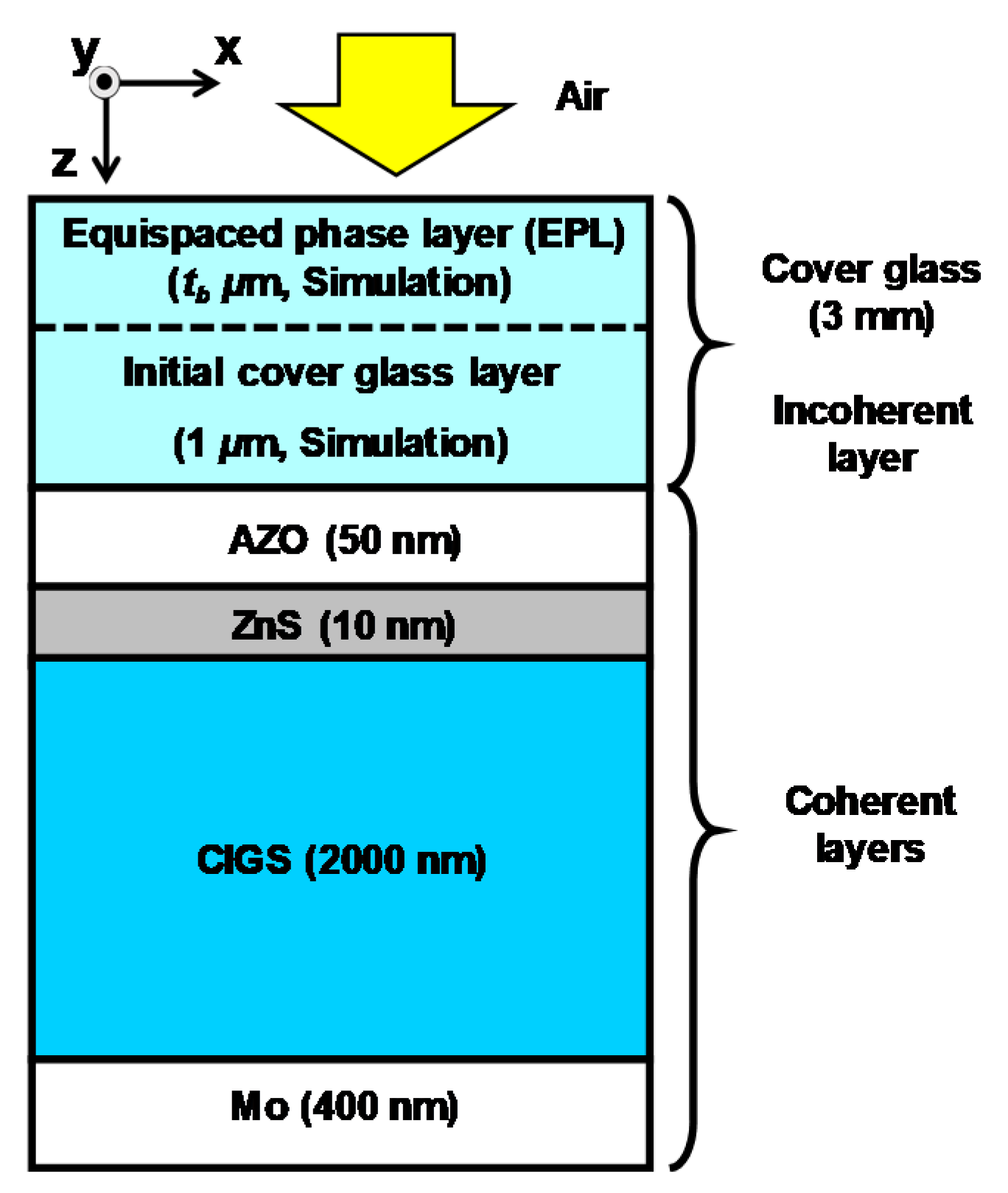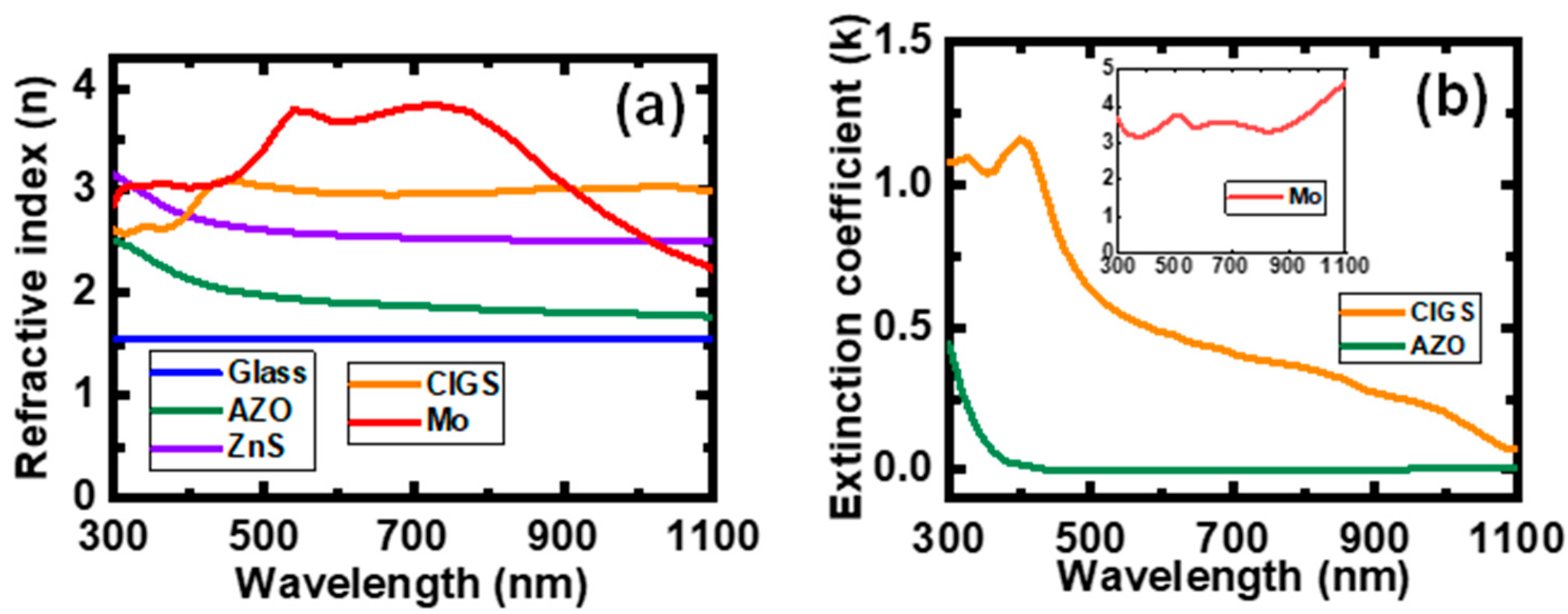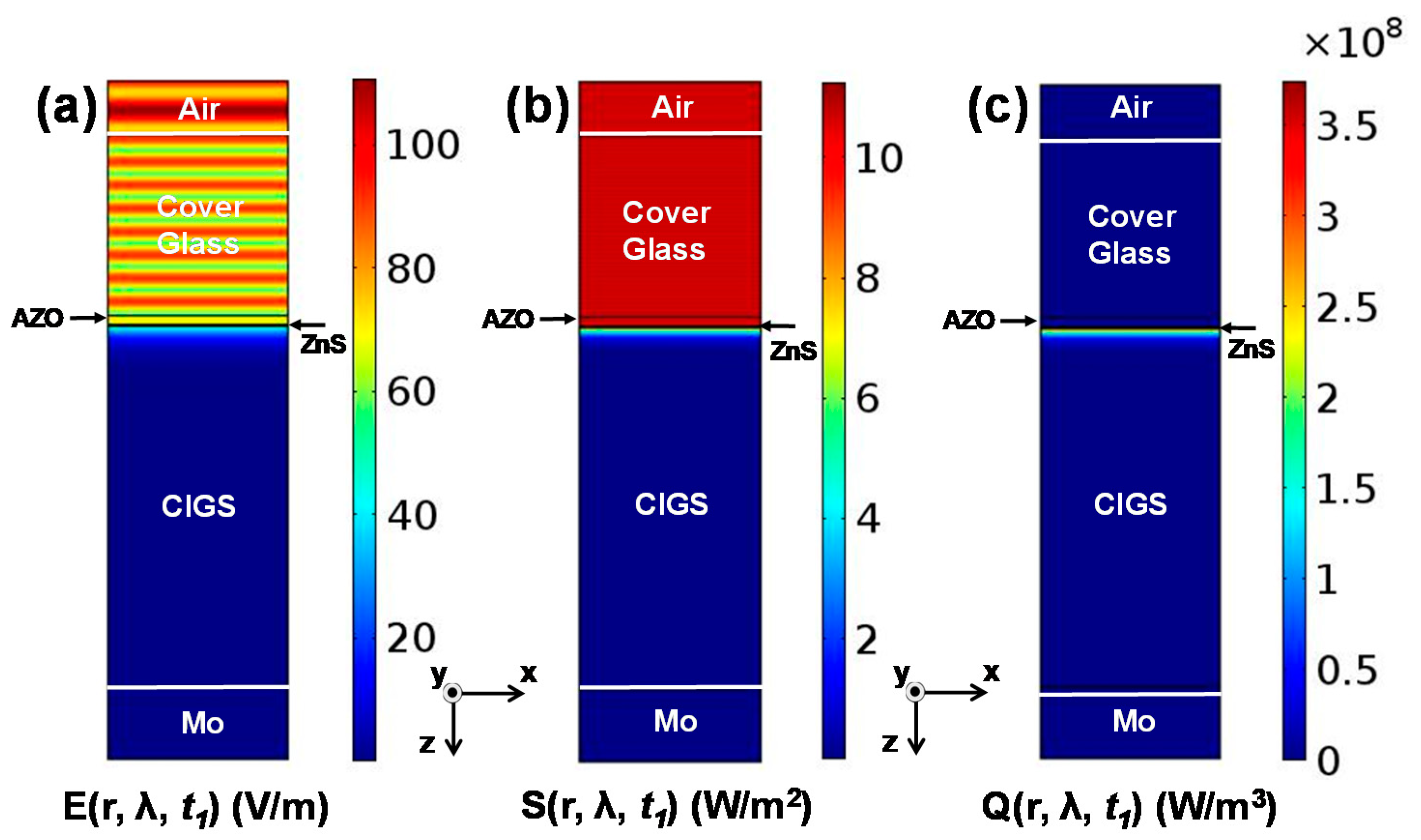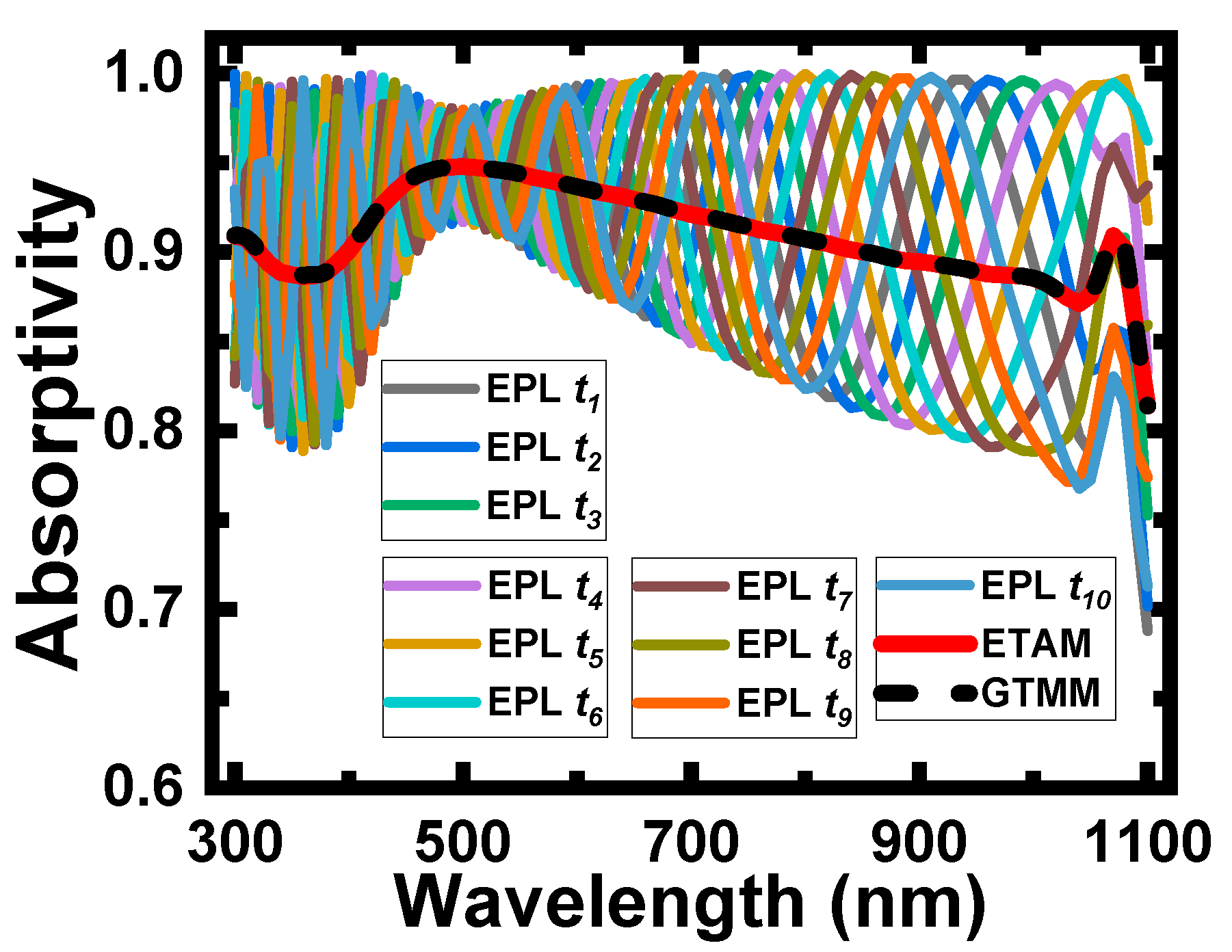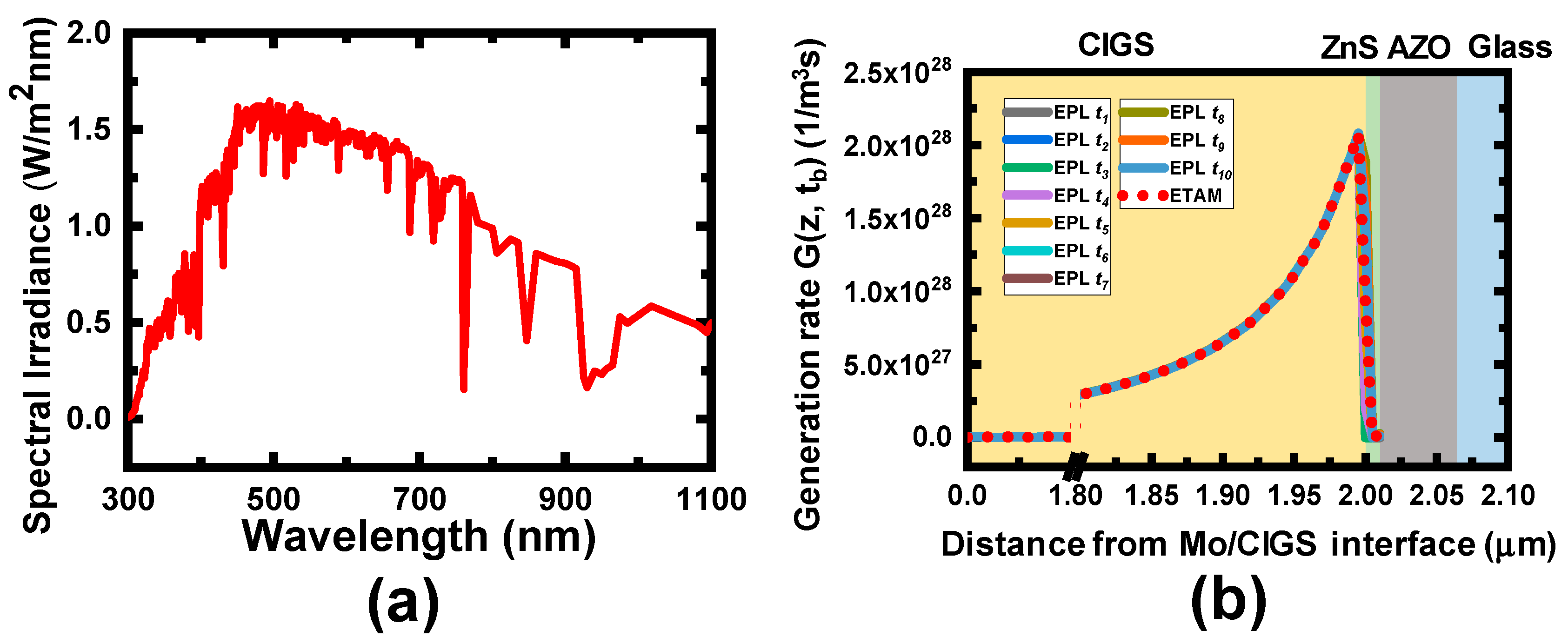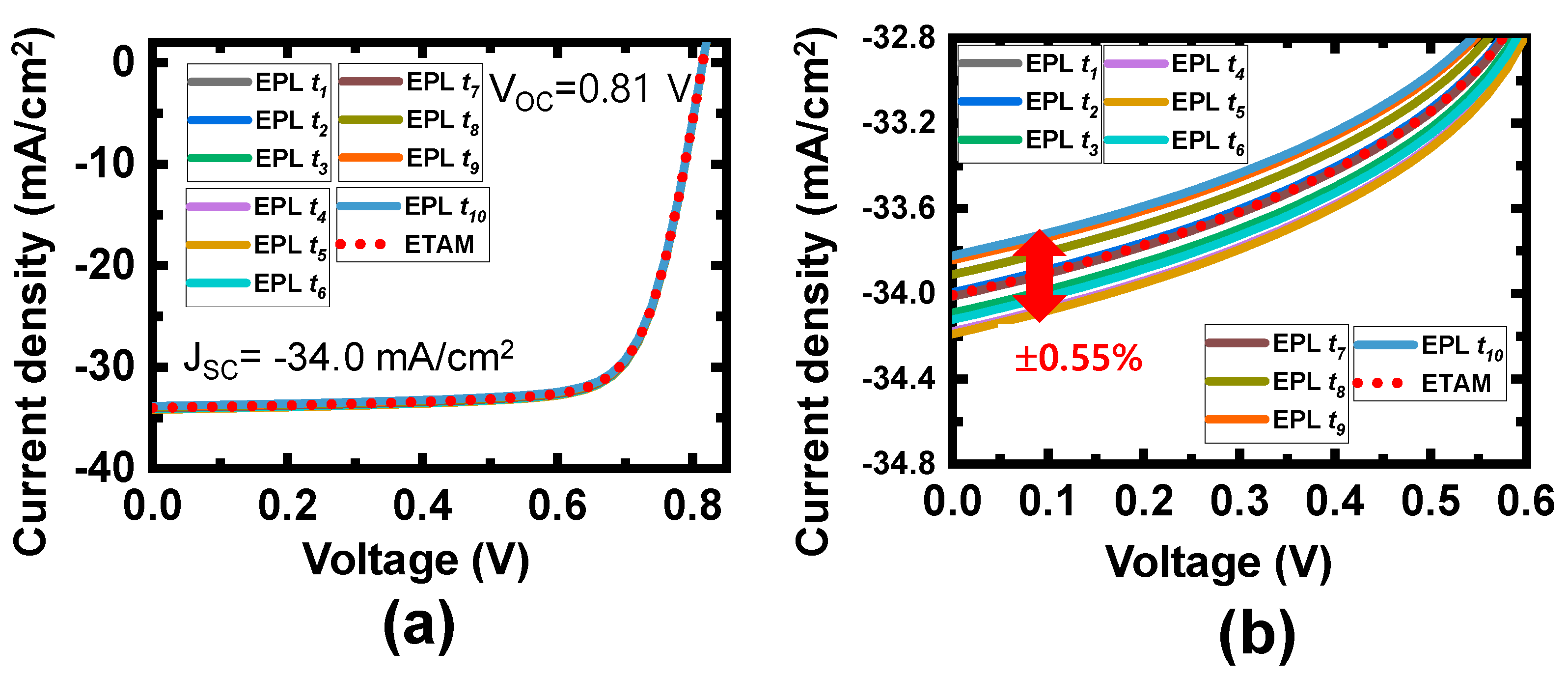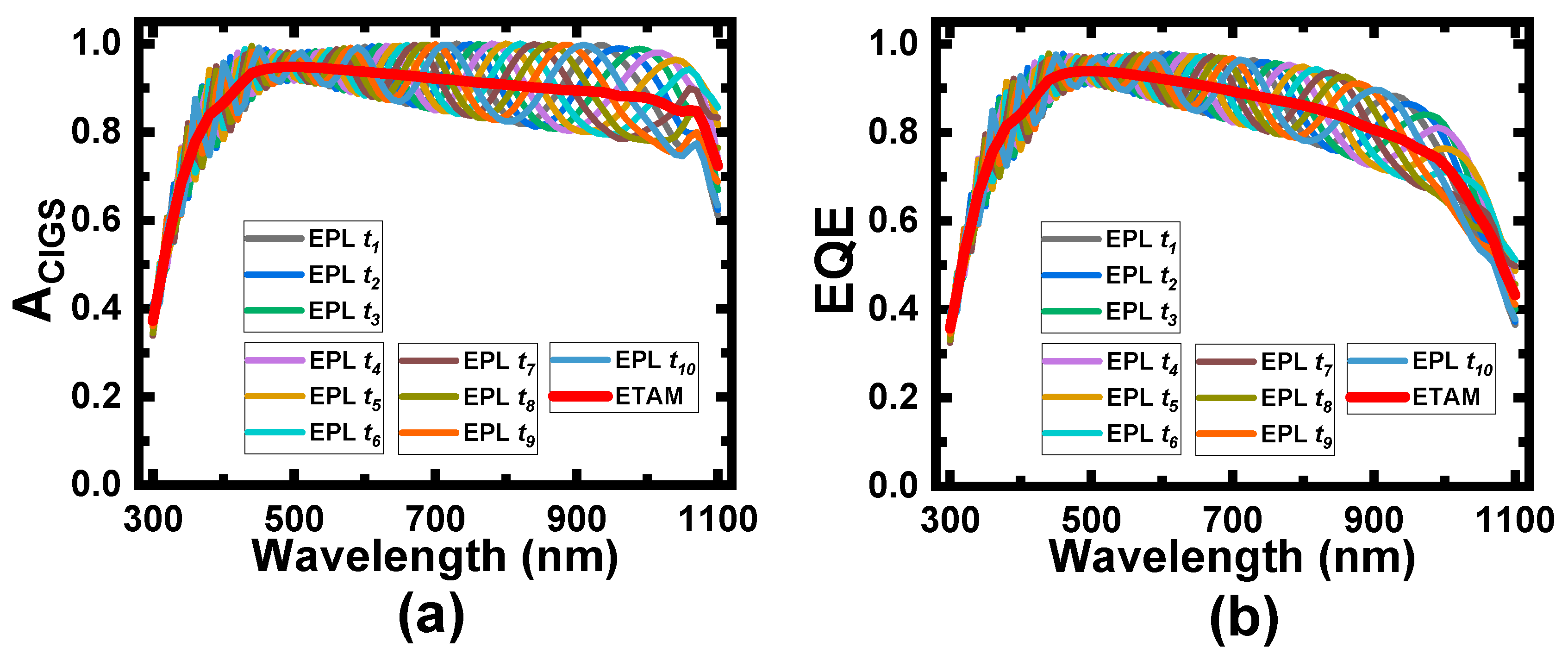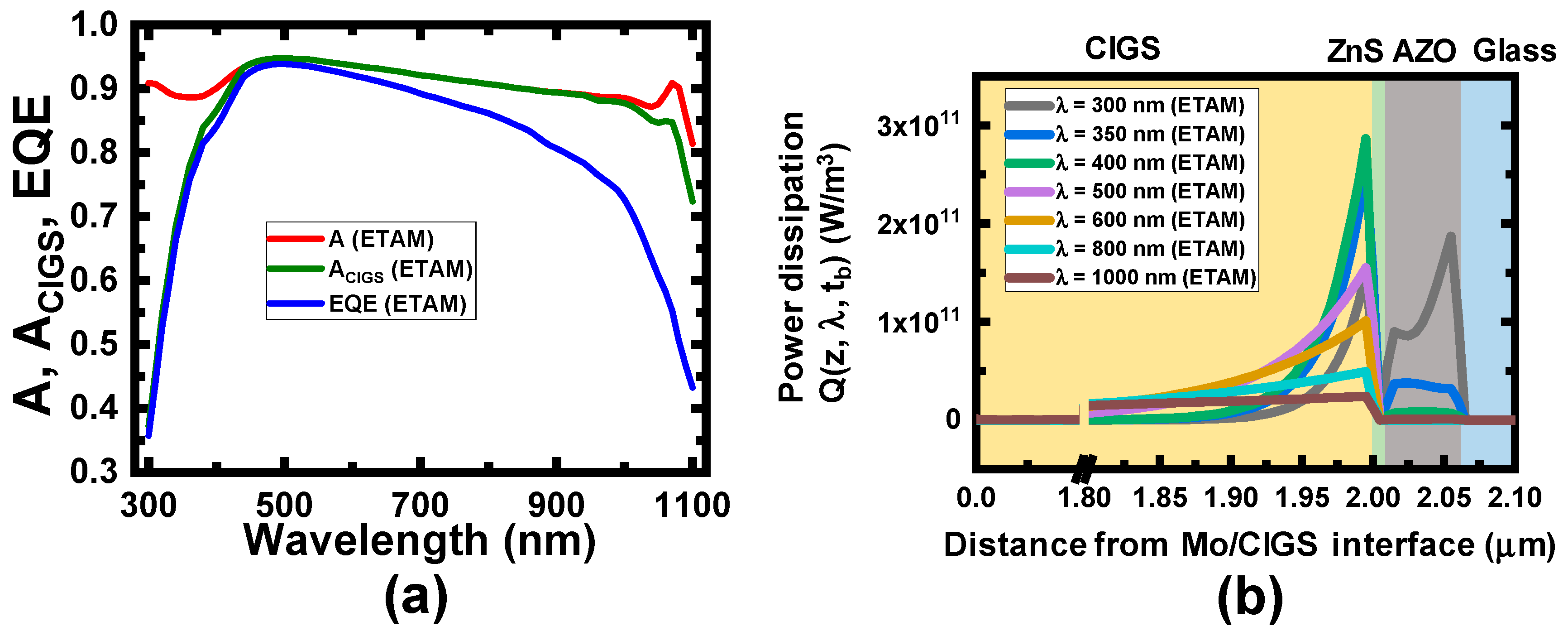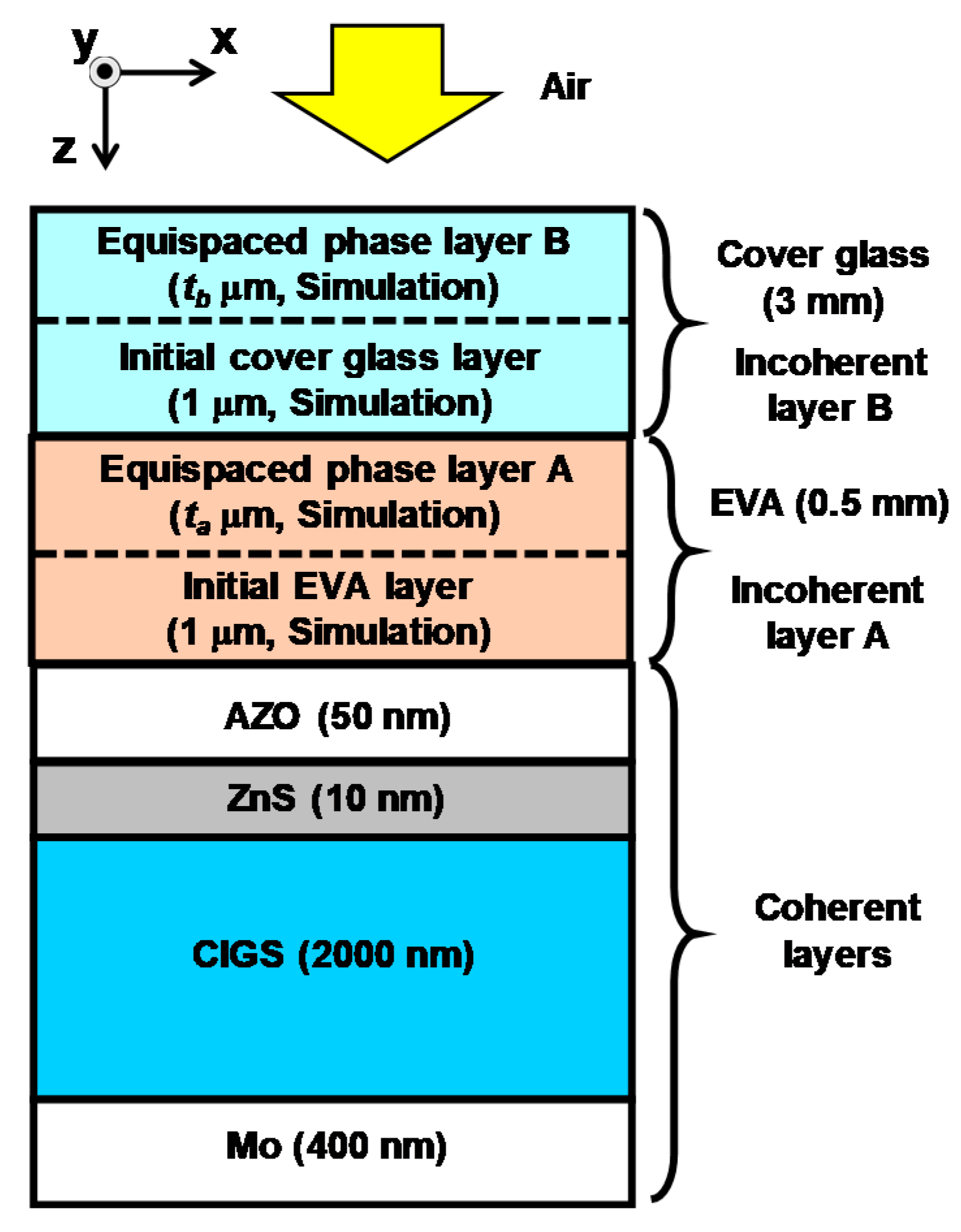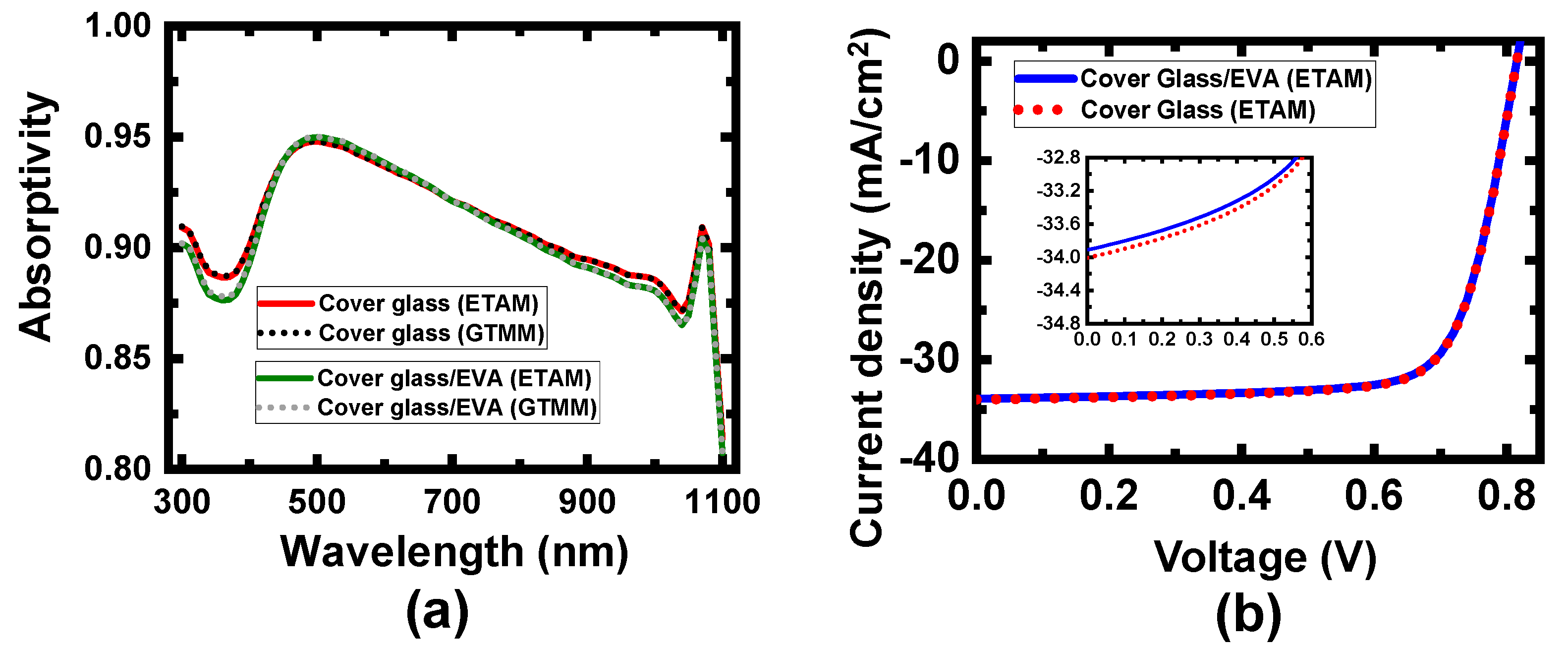1. Introduction
Thin-film solar cells based on a Cu(In,Ga)Se
2 (CIGS) absorption material have been intensively investigated as an auspicious alternative to traditional silicon-based solar cells owing to their low cost and high efficiency [
1,
2,
3]. Because of their high optical absorption coefficient, CIGS solar cells with a wide absorption spectrum and high stability reached a power conversion efficiency of 19.9% in 2008 [
1] and beyond 20% in more recent years [
2,
3]. In general, a CIGS solar cell consists of multiple sub-micrometer layers, which range from a metal back contact to transparent conducting oxide (TCO) top contact layers. In the module configuration, millimeter-thick front encapsulation and cover glass layers are added on the TCO top contact layer to implement glass–glass encapsulating technology, which can provide a higher mechanical durability and operational stability [
4].
Because the coherence length of sunlight is approximately 0.6 μm [
5] (preserving the phase information of the optical field), the multilayer structure of a CIGS solar cell module can be treated as mixed coherent and incoherent layers in optical modeling. Inside the coherent multilayer structure, the thickness of which is much less than the coherence of sunlight, the optical interference effect plays an important role in the optical characteristics of the reflectivity and absorptivity [
6]. By contrast, light experiences a random phase change at each coherence length, such that the optical interference effect, on average, disappears in the incoherent layer [
7,
8]. Thus, this mixed coherent-incoherent multilayer structure of a CIGS solar cell greatly affects the absorption characteristics and has to be thoroughly considered in optoelectronic modeling.
There have been several studies conducted on the optoelectronic modeling of a CIGS solar cell, which have provided the current–voltage (J–V) characteristics obtained through the combination of optical and electrical simulations [
9,
10,
11,
12,
13]. However, the previous optoelectronic modeling results of CIGS solar cells have not included the incoherent front encapsulation or cover glass layers in the optical modeling. Instead, they assumed sunlight to be directly incident from the air into the multilayer structure of the CIGS solar cell. The analytical formulation of a 2 × 2 transfer matrix method (TMM) based on the thin-film optics was used to calculate the optical interference effect within the coherent multilayer structure, which ranged from the TCO top contact layer to the metal back contact layer [
11,
12,
13]. Thus, the previous optoelectronic modeling methods were insufficient when considering the realistic aspect of the optical and electrical characteristics of a CIGS solar cell because the optical effect of the incoherent front layer was not considered.
According to thin-film optics, the absorption spectrum of the mixed coherent-incoherent layer structure of organic solar cells was calculated based on the generalized transfer matrix method (GTMM). Here, the optical behavior of the electric field amplitude in the coherent multilayer was described by the 2 × 2 TMM, and the optical behavior of the electric field intensity in the incoherent layer was modeled by the 2 × 2 intensity matrix formulation [
14,
15]. In numerical methods, such as rigorous coupled-wave analysis (RCWA) and finite element method (FEM), coherent simulation results (obtained through the numerical solution of the wave equation in a small mesh or grid) were averaged out to provide the incoherent characteristics of light propagation in a mixed coherent-incoherent multilayer structure [
16,
17,
18]. The effects of the incoherent front layer on the reflection spectrum of the CIGS solar cell were calculated based on the spectral averaging method in combination with the RCWA [
16,
17].
We recently used the equispaced thickness averaging method (ETAM) to efficiently calculate the effect of the incoherent front layer on the reflection spectra of a CIGS solar cell [
19]. In the ETAM, coherent simulation results (obtained based on a set of equispaced phase thicknesses added to the initial thickness of the incoherent layer) were averaged to optically model the mixed coherent-incoherent multilayer structure. However, the above-mentioned optical modeling methods, which can only consider the effects of the incoherent layer on the absorption characteristics, were also insufficient to obtain the realistic J–V characteristics of a CIGS solar cell owing to their limitations in the electrical model. In addition, it has yet to be investigated how the optical effect of the front incoherent layer affects the J–V characteristics of a CIGS solar cell.
In this study, we investigated the effects of the incoherent front cover glass on the J–V characteristic of a CIGS solar cell. An incoherent cover glass was optically modeled as a 1-μm initial layer plus a set of equispaced phase layers (EPLs), the thicknesses of which are determined based on the ETAM. Both the optical and electrical characteristics of a CIGS solar cell were numerically calculated using an FEM-based integrated optoelectronic model. The changes in the optical power dissipation, absorptivity, and electron–hole pair generation rates were calculated depending on the variation of the equispaced phase thickness of the EPL. To obtain the ETAM-applied calculation, which includes the incoherent property of a thick cover glass layer, coherent optical simulation results were averaged over 10 equispaced phase thicknesses of the EPL. By comparing the J–V characteristics of the CIGS solar cell calculated between coherently and incoherently modeled cover glass layers, we calculated the percent of deviation of the short-circuit current density (JSC) and open-circuit voltage (VOC), which can be considered to be the inaccuracy of the calculation when a thick cover glass layer is inappropriately modeled as a coherent layer.
3. Simulation Results
The optical modeling of the CIGS solar cell in
Figure 1 was conducted based on the two-dimensional (2D) FEM, which was implemented using the RF module of COMSOL Multiphysics [
20]. The complex refractive index spectra of the materials, which were taken from [
21,
22,
23], are shown in
Figure 2. In the FEM simulation, wave equations shown in Equation (1) were numerically solved at very small meshes of the calculation domains with appropriate boundary conditions. We use the port boundary condition at the uppermost boundary of the air domain to generate a plane wave with a wavelength of
λ, which was normally injected into the multilayer structure of the CIGS solar cell. In addition, the Floquet periodic boundary conditions were used at the leftmost and rightmost boundaries of the simulation domain.
If the refractive index of the transparent incoherent cover glass was
ng, the equispaced phase thickness of the EPL can be determined by
When the ETAM is applied to the incoherent modeling of a planar organic solar cell, the accuracy of the calculation results converge if the number of the equispaced phase thicknesses is greater than five [
18]. In this calculation, we set the number of equispaced phase thicknesses to 10. Hence, the corresponding equispaced phase thicknesses of the EPL were
Figure 3 shows the calculated 2D spatial profiles of the electric field amplitude, time-averaged Poynting vector, and optical power dissipation when the equispaced phase thickness of the EPL was set to
t1 = 0 nm. All calculation results were obtained at a wavelength of
λ = 400 nm, where the extinction coefficient of the CIGS material was the largest, as shown in
Figure 2b. In
Figure 3, all calculation results depend only on the longitudinal z-direction and have no spatial dependence of the transverse x-direction, which results from the Floquet periodic boundary condition applied to the leftmost and rightmost boundaries in the optical simulation domain. In
Figure 3b, the time-averaged Poynting vector remains unchanged at the transparent cover glass layer, but continues decreasing at the AZO, ZnS and CIGS layers owing to the gradual light absorption at these layers. Because of the very high absorption coefficient at the 2-μm thick CIGS layer, the optical power dissipation in
Figure 3c was significant near the ZnS/CIGS interface and there was no light absorption near the CIGS/Mo interface. Hence, the CIGS layer can be optically modeled as a coherent layer although its 2-μm thickness was larger than the coherence length of sunlight.
To investigate how the light absorption within the CIGS solar cell was changed depending on the equispaced phase thickness of the EPL, the spatial profiles of the optical power dissipations were calculated at 10 different equispaced phase thicknesses of
t1,
t2, ⋅⋅⋅ and
t10 when the wavelengths of sunlight were 400 and 800 nm. Because the 2D calculation results obtained through the optical modeling, as shown in
Figure 3, depend only on the longitudinal z-direction owing to the periodic boundary condition applied to the transverse x-direction, the calculated spatial profiles in
Figure 4 were plotted in the longitudinal z-direction. In
Figure 4a, the overall exponentially decaying shapes of the optical absorption calculated at different thicknesses of the EPL were comparable to each other except for their relative magnitudes. This was ascribed to the difference in the optical phase change induced by the respective thickness of the EPL in the cover glass layer. The ETAM-applied optical power dissipation, which includes the optically incoherent characteristics of the cover glass layer, lies in the middle of the 10 coherent calculation results. If the cover glass was considered optically incoherent, all the spatial profiles of the optical power dissipations calculated at 10 different equispaced phase thicknesses will be the same as the ETAM-applied calculation result. By comparing the aggregate sums of the optical power dissipations distributed at the CIGS layer between the coherent and ETAM-applied models, we obtain a deviation within the range of −9.65% to +10.22%, which can be considered as the inaccuracy of the calculation when a thick cover glass was inappropriately modeled as the coherent layer.
The variations in the optical power dissipations depending on the equispaced phase thickness of the EPL were also calculated in
Figure 4b when the wavelength of sunlight was 800 nm. The overall shapes of the calculation results in
Figure 4b are comparable to those in
Figure 4a. When the aggregate sums of the optical power dissipations positioned at the CIGS layer were compared between the coherent and ETAM-applied models, a deviation of −9.60% to +10.17% was obtained. It was noticeable that the calculated optical power dissipations in
Figure 4b decrease more slowly from the ZnS/CIGS interface toward the CIGS layer than the calculated optical power dissipations in
Figure 4a. This can be explained by the fact that the extinction coefficient of the CIGS layer, which can be seen in
Figure 2b, decreases as the wavelength increases from 400 to 800 nm.
Figure 5 shows the calculation results of the absorptivity spectra depending on 10 different equispaced phase thicknesses of
t1,
t2, ⋅⋅⋅ and t
10 along with the ETAM-applied absorptivity. According to Equations (4) and (6), the absorptivity corresponds to the accumulated sum of the optical power dissipation in the longitudinal z-direction at a given wavelength. As indicated in
Figure 5, the absorptivity spectrum calculated at each equispaced phase thickness shows a respective ripple. This results from the fact that the wave vector of
and the complex refractive index in
Figure 2 depend on the wavelength of light, which causes a wavelength-dependent optical phase change and an optical interference effect. Owing to the additional optical phase change induced by the different thicknesses of the EPL
tb in
Figure 1, the spectral positions of the peaks and valleys were shifted in the absorptivity spectra calculated at different equispaced phase thicknesses of
t1,
t2, ⋅⋅⋅ and t
10. However, these ripples in the absorptivity spectra disappear in the calculation results obtained by the ETAM, where the calculation results of 10 coherently calculated absorptivity spectra were averaged to include the optically incoherent characteristics of the cover glass layer. For comparison, the absorptivity was also calculated based on the GTMM, which was considered another analytical model to include the incoherent effect of the cover glass layer. The numerical results based on the ETAM were in agreement with the analytical results based on the GTMM, which verifies the validity of the calculation results obtained using the ETAM. In addition, the ETAM-applied absorptivity spectrum has the average value among the 10 coherently modeled absorptivity spectra. At a wavelength of 400 nm, as shown in
Figure 5, the variation of the coherently modeled absorptivity in reference to the ETAM-applied absorptivity was observed to be within the range of −9.52% to +10.44%, which was close to the range of the deviation of the optical power dissipation shown in
Figure 4a.
The final step of the optical modeling was to calculate the spatial profile of the generation rate of the electron–hole pair, which was one of the input parameters of the continuity equation in the electrical modeling. According to Equations (7) and (8), the generation rate of the electron–hole pair was obtained by integrating the optical power dissipation weighted by the spectral irradiance of AM 1.5 sunlight, as shown in
Figure 6a.
Figure 6b shows the calculated spatial profiles of the generation rate in the longitudinal z-direction
with respect to 10 different equispaced phase thicknesses of
t1,
t2, ⋅⋅⋅ and
t10. To include the incoherent effect of the thick cover glass, the ETAM-applied generation rate in the longitudinal z-direction
was also plotted in the red dotted line. The overall exponentially decaying shapes of the generation rates in
Figure 6b were comparable to those of the optical power dissipations in
Figure 4. In comparison with the aggregate sums of the generation rates between the coherent and ETAM-applied models, the deviation was calculated to be between −0.67% and +0.9%. This value was much smaller than the maximal absolute deviations calculated under the optical power dissipations shown in
Figure 4a (10.22%) and the absorptivity in
Figure 5 (10.44%), which results from the significant dependence of both the wavelength of sunlight and the thickness of the EPL. By contrast, the generation rate corresponds to the accumulated sum of the optical power dissipation within the wavelength region ranging between 300 and 1100 nm. Thus, the generation rate calculated at each equispaced phase thickness was less sensitive to the change in wavelength, which causes a reduction of the percentage variation of the electron–hole pair generation rate.
To obtain the J–V characteristics of a CIGS solar cell, the coupled drift–diffusion and continuity equations, shown in Equations (9)–(16), were numerically solved through the use of the semiconductor module of COMSOL multiphysics [
20]. In the 2D simulation domain of the CIGS solar cell in
Figure 1, we only consider the regions containing the ZnS and CIGS layers for the electrical modeling. Both the bottom cathode terminal of the Mo/CIGS interface and the top anode terminal of the AZO/ZnS interface were assumed to be ideal Schottky contacts. In accordance with the Floquet periodic boundary condition in the optical modeling, the periodic conditions were used at the leftmost and rightmost boundaries of the simulation domain in the electrical modeling. The FEM-based electrical modeling was performed under the same mesh configuration as the FEM-based optical modeling to minimize the error of a mismatch. The simulation parameters used in the electrical modeling are shown in
Table 1 [
24].
Figure 7a shows the calculated J–V characteristics of a CIGS solar cell depending on the equispaced phase thickness of the EPL. In addition, the ETAM-applied J–V curve, where the ETAM-applied generation rate was used in the electrical modeling, was also plotted along the red dotted line. None of the eleven calculation results of the J–V curves can be distinguished in
Figure 7a due to their extremely small differences at this J–V scale. In the ETAM-applied J–V curve, the calculated values of J
SC and V
OC were −34.0 mA/cm
2 and 0.81 V, respectively, which were close to other calculation results of J
SC and V
OC in a similar CIGS solar cell structure [
25]. A close view of the J–V characteristics at near the zero applied voltage is shown in
Figure 7b. The deviation of J
SC calculated between the coherent and ETAM-applied models lies within the range of −0.54% to +0.54%, which was close to the −0.67% to +0.9% deviation obtained by the aggregate sums of the electron–hole pair generation rates between the coherent and ETAM-applied models. In addition, the maximal deviation of V
OC was as small as ± 0.017%, which was ascribed to the fact that V
OC has a logarithmic dependence on the carrier density [
26].
It is notable that the ±0.54% maximal percent deviation of J
SC can be understood to be the inaccuracy of the calculation when a thick cover glass layer was inappropriately modeled as a coherent layer. An arbitrarily determined thickness of the coherently modeled cover glass can provide a random optical phase change ranging between 0 and 2π. This will result in a different optical interference effect in the multilayer structure of a CIGS solar cell and affect all of the calculation results, such as the optical power dissipation in
Figure 4, the generation rate in
Figure 6b, and the J–V characteristics in
Figure 7. Because 10 equispaced phase thicknesses of the EPL used in the ETAM correspond to equally spaced optical phase changes ranging between 0 and 2π, 10 coherent calculation results of the optical power dissipations, electron–hole pair generation rates and J–V characteristics with respect to the equispaced phase thicknesses of the EPL can be speculated to represent the range of variation of the calculation inaccuracy caused by the equispaced phase thicknesses of the coherently modeled cover glass. By contrast, the optical modeling of the ETAM-applied cover glass provides the exact solution to the optical power dissipation, generation rate and J–V characteristic, despite the thickness of the cover glass layer being arbitrarily determined. Therefore, the front cover glass must be modeled as optically incoherent to improve the calculation accuracy of the J–V and optical absorption characteristics in the optoelectronic modeling of a CIGS solar cell.
4. Discussion
To investigate which wavelength affects the variation of J
SC in
Figure 7 further, we calculate the EPL-thickness dependence of absorptivity in the CIGS absorber layer and external quantum efficiency (EQE), which are shown in
Figure 8. The absorptivity in the CIGS absorber layer was obtained by integrating the optical power dissipation in the longitudinal z-direction over the CIGS absorber layer and was written as
The EQE was defined as the ratio of the number of charge carriers collected by the solar cell to the number of incident photons shining on the solar cell outside. In this calculation, the EQE spectra was expressed as
where
indicates the EPL-thickness-dependent spectral short-circuit current density, which was obtained by the numerical solution of the coupled drift–diffusion and continuity equations when the incident optical power was set to the spectral irradiance of AM 1.5 sunlight
. In
Figure 8, the ETAM-applied calculation results were obtained by averaging 10 coherent calculation results over the equispaced phase thicknesses. According to the calculated EQE spectra in
Figure 8b, the variation of the EQE with respect to the EPL thickness was noticeable around the wavelength range between 600 and 1000 nm.
Figure 9a shows the ETAM-applied calculation results of absorptivity in the entire multilayer structure, the absorptivity in the CIGS absorber layer and the EQE, where a significant reduction of the EQE was observed within the relatively short (300–450 nm) and long (1000–1100 nm) wavelength ranges. First, the reduction of the EQE between 300 and 450 nm was ascribed to the optical absorption in the AZO-based TCO layer, which has a high extinction coefficient within the short wavelength range, as shown in
Figure 2b. Hence, the difference in the absorptivity between the entire multilayer structure and the CIGS absorber layer becomes very high within the wavelength range of 300–450 nm. This fact was also confirmed by the ETAM-applied spatial profiles of the optical power dissipations shown in
Figure 9b, where the optical power dissipation at the AZO layer was observed at wavelengths of 300, 350 and 400 nm. Second, the difference between the absorptivity and EQE in
Figure 9a increases as the wavelength increases from 500 to 1100 nm. As shown in
Figure 9b, this can be explained by the fact that the optical absorption, taking place farther away from the interface between the p-doped CIGS and n-doped ZnS layers at a longer wavelength, contributes less to the electric current at a longer wavelength due to the low diffusion length of the minority electron carriers [
26].
In the actual module configuration of the CIGS solar cell, the front encapsulation layer, made of ethylene vinyl acetate (EVA), lies between the front cover glass and the TCO top contact layer [
4].
Figure 10 shows a modified schematic diagram of the CIGS solar cell, where a 0.5-mm EVA encapsulation layer was added into the multilayer structure of the CIGS solar cell shown in
Figure 1 [
17,
19]. Because the thickness of the EVA layer (0.5 mm) was much larger than the coherence length of sunlight (~0.6 μm), the EVA layer should also be considered optically incoherent. The EVA layer was assumed to be transparent with a constant refractive index of 1.49 between 300 and 1100 nm [
19]. According to the optical modeling based on the ETAM, the incoherent cover glass and EVA layers can be modeled as an initial 1-μm layer plus the EPL layer, respectively. The optically incoherent characteristics of the cover glass/EVA layer can then be considered by averaging the coherent simulation results over all combinations of the equispaced phase thicknesses in two incoherent layers [
19]. For instance, the ETAM-applied optical power dissipation, which includes the effect of the incoherent cover glass/EVA layer, can be obtained by
where
M and
N indicate the number of equispaced phase thicknesses in the EVA and cover glass layers, respectively. If the number of equispaced phase thicknesses was set to 10 for both incoherent layers, the ETAM-applied optical power dissipation can be calculated by averaging the coherent calculation results
over 100 combinations of the equispaced phase thicknesses in two incoherent layers.
Figure 11 shows the calculation results of the ETAM-applied absorptivity spectra and J–V characteristics of a CIGS solar cell having only a cover glass (
Figure 1) or a cover glass/EVA as an incoherent layer (
Figure 10). In
Figure 11a, the absorptivity spectra calculated by the GTMM show a good agreement with those obtained by the ETAM, which verifies the validity of the calculation results obtained using the ETAM. There was a slight difference between the two calculation results of absorptivity because the difference in the refractive index between the cover glass (1.55) and EVA (1.49) was very small. Hence, the calculated values of J
SC between the cover glass/AZO/ZnS/CIGS/Mo (−34 mA/cm
2) and cover glass/EVA/AZO/ZnS/CIGS/Mo (−33.91 mA/cm
2) structures were very close and deviate by 0.26%. This indicates that the addition of the incoherent EVA encapsulation layer into the multilayer structure of the CIGS solar cell in
Figure 1 will provide little change in either the optical or electrical calculation results shown in
Figure 3,
Figure 4,
Figure 5,
Figure 6 and
Figure 7, where only a cover glass was considered as the incoherent layer.
